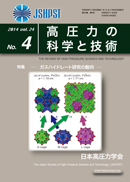Volume 24, Issue 4
Displaying 1-10 of 10 articles from this issue
- |<
- <
- 1
- >
- >|
Foreword
-
2014 Volume 24 Issue 4 Pages 255-256
Published: 2014
Released on J-STAGE: December 25, 2014
Download PDF (159K)
Reviews—Recent Trends of Gas Hydrate Research—
-
2014 Volume 24 Issue 4 Pages 258-264
Published: 2014
Released on J-STAGE: December 25, 2014
Download PDF (379K) -
2014 Volume 24 Issue 4 Pages 265-269
Published: 2014
Released on J-STAGE: December 25, 2014
Download PDF (574K) -
2014 Volume 24 Issue 4 Pages 270-277
Published: 2014
Released on J-STAGE: December 25, 2014
Download PDF (494K) -
2014 Volume 24 Issue 4 Pages 278-287
Published: 2014
Released on J-STAGE: December 25, 2014
Download PDF (571K) -
2014 Volume 24 Issue 4 Pages 288-294
Published: 2014
Released on J-STAGE: December 25, 2014
Download PDF (477K)
Laboratory News
-
2014 Volume 24 Issue 4 Pages 295-296
Published: 2014
Released on J-STAGE: December 25, 2014
Download PDF (288K)
Salon
-
2014 Volume 24 Issue 4 Pages 297-298
Published: 2014
Released on J-STAGE: December 25, 2014
Download PDF (247K) -
2014 Volume 24 Issue 4 Pages 299-300
Published: 2014
Released on J-STAGE: December 25, 2014
Download PDF (244K) -
2014 Volume 24 Issue 4 Pages 301-302
Published: 2014
Released on J-STAGE: December 25, 2014
Download PDF (231K)
- |<
- <
- 1
- >
- >|
